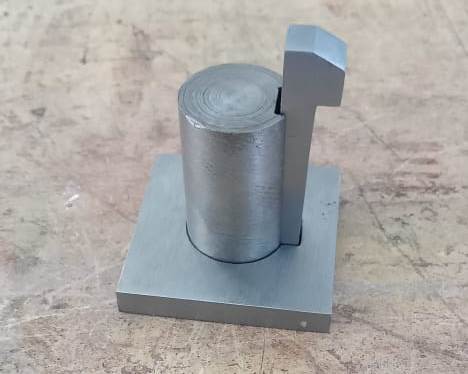Monday, February 28, 2022
GUEST FACULTY FROM NTTF - TRICHY DATE : 01-03-2022
Sunday, February 27, 2022
Tuesday, February 22, 2022
குறுக்குவழி கணிதம் - TAMIL
அறிமுகம்
மூலைகளை வெட்டுதல் ஆர்வம் காரணமாகவோ அல்லது சுத்த சோம்பேறித்தனத்தின் காரணமாகவோ, மனிதன் தன் வேலையை எளிதாக்குவதற்கான வழிகளை சோதித்து, தேடி, தடுமாறிக்கொண்டே இருக்கிறான். ஒரு தட்டையான பாறையின் மூலைகளை வெட்டி சக்கரத்தை கண்டுபிடித்த அந்த அநாமதேய சுட்டி குகைமனிதன் இந்த பாரம்பரியத்தை ஆரம்பித்தான். கடந்த காலத்தில் மனிதனின் பெரும்பாலான முயற்சிகள் அவனது தசை சக்தியைப் பாதுகாப்பது அல்லது அதிகரிப்பதை நோக்கமாகக் கொண்டிருந்தன. அவரது மூளை. கணக்கீடு செய்வது போன்ற கடினமான வேலைகளைக் குறைப்பதில் அவரது கவனம் திரும்பியது இயல்பாகவே தொடர்ந்தது.
ஷார்ட் கட்ஸ் என்றால் என்ன?
கணிதத்தில் குறுக்குவெட்டுகள் என்பது கணக்கீடு செய்வதில் உள்ள புத்திசாலித்தனமான சிறிய தந்திரங்கள் ஆகும், இது மகத்தான நேரத்தையும் உழைப்பையும் மிச்சப்படுத்துகிறது. இந்த தந்திரங்களுடன் தொடர்புடைய மந்திர சக்திகள் எதுவும் இல்லை: ஒவ்வொன்றும் எண்களின் பண்புகளில் இருந்து வளரும் ஒலி கணித அடிப்படைகளை அடிப்படையாகக் கொண்டது .அவை உருவாக்கும் முடிவுகள் முற்றிலும் துல்லியமானவை மற்றும் சரியாகப் பயன்படுத்தப்படும் போது நம்பமுடியாதவை. குறுகிய வெட்டு முறைகள் சமீபத்தியவை அல்ல. தோற்றம்: அவர்கள் பண்டைய கிரேக்கர்களுக்கு கூட தெரிந்திருந்தனர். குறுக்குவழிகளின் வழங்கல் வரம்பற்றது. பல அறியப்பட்டவை, இன்னும் பல கண்டுபிடிக்கப்படவில்லை. இந்தப் பக்கத்தில் சேர்க்கப்பட்டுள்ள அனைத்து குறுக்குவழிகளும் தேர்ந்தெடுக்கப்பட்டன, ஏனெனில் அவை கற்றுக்கொள்வது எளிது, பயன்படுத்த எளிதானது மற்றும் பரந்த அளவிலான கணக்கீட்டு சிக்கல்களுக்குப் பயன்படுத்தலாம்.
1)
தொடர்ச்சியான எண்களைச் சேர்த்தல்
விதி:
(குழுவில் உள்ள மிகச்சிறிய எண்ணை, குழுவில் உள்ள பெரிய எண்ணுடன் சேர்த்து, முடிவை குழுவில் உள்ள எண்களின் எண்ணிக்கையால் பெருக்கி, அதன் விளைவாக வரும் பொருளை 2 ஆல் வகுக்கவும்.)
33 முதல் 41 வரை உள்ள அனைத்து எண்களின் கூட்டுத்தொகையைக் கண்டுபிடிக்க வேண்டும் என்று வைத்துக்கொள்வோம். முதலில், மிகப்பெரிய எண்ணுடன் சிறிய எண்ணைச் சேர்க்கவும்.
33 + 41 = 74
33 முதல் 41 வரை ஒன்பது எண்கள் இருப்பதால், அடுத்த படி
74 x 9 = 666
இறுதியாக, முடிவை 2 ஆல் வகுக்கவும்.
66 / 2 = 333 பதில்
எனவே 33 முதல் 41 வரை உள்ள அனைத்து எண்களின் கூட்டுத்தொகை 333 ஆகும்.
2)
1 இலிருந்து தொடங்கும் தொடர்ச்சியான எண்களைச் சேர்த்தல்
1, 2, 3, 4, 5, 6, 7, 8 மற்றும் 9 போன்ற தொடர் எண்களின் குழுவைச் சேர்ப்பதில் உள்ள சிக்கலைக் கவனியுங்கள். அவற்றின் கூட்டுத்தொகையை எப்படிக் கண்டுபிடிப்பீர்கள்?
வழக்கமான வழியைச் சேர்க்க இந்தக் குழு மிகவும் எளிதானது.
ஆனால் நீங்கள் உண்மையிலேயே புத்திசாலியாக இருந்தால், முதல் எண், 1, கடைசி எண்ணுடன் சேர்க்கப்பட்ட 9, மொத்தம் 10 மற்றும் இரண்டாவது எண், 2, மற்றும் கடைசி எண்ணுக்கு அடுத்த எண், 8, கூட மொத்தம் 10 என்பதை நீங்கள் கவனிக்கலாம்.
உண்மையில், இரு முனைகளிலிருந்தும் தொடங்கி ஜோடிகளைச் சேர்த்தால், ஒவ்வொரு விஷயத்திலும் மொத்தம் 10 ஆகும். நான்கு ஜோடிகள் இருப்பதைக் காண்கிறோம், ஒவ்வொன்றும் 10ஐச் சேர்க்கிறது; எண் 5 க்கு ஜோடி இல்லை.
இவ்வாறு 4 x 10 = 40 ; 40 + 5 = 45
ஒரு படி மேலே சென்று, ஒரு வரிசையில் உள்ள பல எண்களின் கூட்டுத்தொகையை நாம் விரும்பியபடி கண்டுபிடிக்கும் முறையை உருவாக்கலாம்.
ஒரு படி மேலே சென்று, ஒரு வரிசையில் உள்ள பல எண்களின் கூட்டுத்தொகையை நாம் விரும்பியபடி கண்டுபிடிக்கும் முறையை உருவாக்கலாம்.
விதி:
(குழுவில் உள்ள எண்களின் எண்ணிக்கையை அவற்றின் எண்ணிக்கையை விட ஒன்றால் பெருக்கி, 2 ஆல் வகுக்கவும்.)
எடுத்துக்காட்டாக, 1 முதல் 99 வரையிலான அனைத்து எண்களின் கூட்டுத்தொகையைக் கண்டறியும்படி கேட்கப்படுகிறோம். இதனால்
99 X 100 = 9,900
9,900 / 2 = 4,950 பதில்
எனவே 1 முதல் 99 வரை உள்ள அனைத்து எண்களின் கூட்டுத்தொகை 4,950 ஆகும்.
3)
1 முதல் தொடங்கும் அனைத்து ஒற்றைப்படை எண்களின் கூட்டுத்தொகையைக் கண்டறிதல்
விதி :
(1 முதல் 100 வரையிலான எண்களின் அளவு கணக்கிடப்படும்.)
இந்தக் குழுவில் 50 ஒற்றைப்படை எண்கள் உள்ளன.
எனவே
50 x 50 = 2,500 பதில்
இது 1 முதல் 100 வரையிலான அனைத்து ஒற்றைப்படை எண்களின் கூட்டுத்தொகையாகும். சரிபார்ப்பாக, இந்த பதிலை நாம் குறுக்குவழிகள் 2 மற்றும் 4 இல் உள்ள பதில்களுடன் ஒப்பிடலாம்.
4)
2 இலிருந்து தொடங்கும் அனைத்து சம எண்களின் கூட்டுத்தொகையைக் கண்டறிதல்
விதி:
( குழுவில் உள்ள எண்களின் எண்ணிக்கையை அவற்றின் எண்ணிக்கையை விட மேலும் ஒன்றால் பெருக்கவும்)
1 முதல் 100 வரையிலான அனைத்து இரட்டை எண்களின் கூட்டுத்தொகையைக் கண்டறிய இந்த விதியைப் பயன்படுத்துவோம்.
எண்களின் ஹால் சமமாகவும் பாதி ஒற்றைப்படை எண்களாகவும் இருக்கும், அதாவது 50 இரட்டை எண்கள் உள்ளன
1 முதல் 100 வரை.
விதியைப் பயன்படுத்துதல்,
50x 51 = 2,550
இவ்வாறு 1 முதல் 100 வரையிலான அனைத்து இரட்டை எண்களின் கூட்டுத்தொகை 2,550.In
குறுக்குவழி 2 1 முதல் 99 வரை உள்ள அனைத்து எண்களின் கூட்டுத்தொகை 4,950
இதன் விளைவாக 1 முதல் 100 வரையிலான அனைத்து எண்களின் கூட்டுத்தொகை 5,050 ஆகும்.
குறுக்குவழி 3 இல் 1 முதல் 100 வரையிலான அனைத்து ஒற்றைப்படை எண்களின் கூட்டுத்தொகை 2,500 ஆகக் காணப்பட்டது. எனவே 1 முதல் 100 வரையிலான அனைத்து இரட்டை எண்களின் கூட்டுத்தொகைக்கும் எங்கள் பதில் ஒத்துப்போகிறது.
அனைத்து எண்களின் கூட்டுத்தொகை 5,050 – அனைத்து ஒற்றைப்படை எண்களின் கூட்டுத்தொகை 2,500 = அனைத்து இரட்டை எண்களின் கூட்டுத்தொகை 2,550
5)
பொதுவான வேறுபாட்டுடன் எண்களின் வரிசையைச் சேர்த்தல்
சில நேரங்களில் பொதுவான வேறுபாட்டைக் கொண்ட எண்களின் குழுவைச் சேர்க்க வேண்டியது அவசியம். பொதுவான வேறுபாடு என்னவாக இருந்தாலும், எத்தனை எண்கள் சேர்க்கப்பட்டாலும், விடையைப் பெறுவதற்கு ஒரே ஒரு கூட்டல், பெருக்கல், வகுத்தல் அவசியம்.
விதி:
(பெரிய எண்ணுடன் சிறிய எண்ணைச் சேர்த்து, குழுவில் உள்ள எண்களின் தொகையால் கூட்டுத்தொகையைப் பெருக்கி, 2 ஆல் வகுக்கவும்)
உதாரணமாக, பின்வரும் எண்களின் கூட்டுத்தொகையைக் கண்டுபிடிப்போம்
87, 91, 95, 99 மற்றும் 103
அருகில் உள்ள எண்களுக்கு இடையே உள்ள வேறுபாடு எப்போதும் 4. எனவே இந்த குறுக்குவழி முறையைப் பயன்படுத்தலாம். சிறிய எண்ணான 87ஐ பெரிய எண்ணான 103 உடன் சேர்க்கவும்.
குழுவில் ஐந்து எண்கள் இருப்பதால், கூட்டுத்தொகை, 190 ஐ 5 ஆல் பெருக்கவும்.
190 x 5= 950
பதிலைப் பெற 2 ஆல் வகுக்கவும்.
950 / 2 = 475 பதில்
இவ்வாறு 87+ 91 95 + 99 +103 = 475.
(இயற்கையாகவே, இது ஷார்ட்கட் 1 இல் உள்ள விதியைப் போலவே உள்ளது, ஏனென்றால் ஒன்றுக்கு பொதுவான வேறுபாட்டுடன் எண்களின் வரிசையை நாங்கள் சேர்த்துள்ளோம். எனவே, நினைவில் வைத்துக் கொள்ள, நீங்கள் குறுக்குவழிகள் 1 மற்றும் 5 ஐ இணைக்கலாம்.)
EASY MATHS METHOD - TYPE II
INTRODUCTION
CUTTING CORNERS
Whether due to curiosity or sheer laziness , man has always been expeimenting , searching for and stumbling up on ways of making work easier for himseif . That anony mous caveman who chipped the corners off a flat rock and invented the wheel started this tradition .
Most of man’ s efforts in the past were directed at con- serving or increasing his muscle power’ but as time went on some were aimed at saving weat and teat on another vital organ; his brain. It followed naturally that his attention turned to reducing such laborious tasks as calculating.
WHAT SHORT CUTS ARE
Short cuts in mathematics are ingenious little tricks in calculating that can save enormous amounts of time and labour _ not to mention paper – in solving otherwise complicated problems. There are no magical powers connected with these tricks: each is based on sound mathematical principals growing out of the very properties of numbers themselves .The results they produce are absoulutly accurate and inflallible when applied correctly .Short-cut methods are by no means of recent origin:they were known even to the ancient Greeks. The supply of Short-cuts is unlimitted. Many are known ,and many are yet to be discovered. The all shortcuts included in this page have been selected because they are easy to learn,simple to use and can be applied to the widest range of calculating problems.
PUTTING NUMBERS IN THEIR PLACE
The numbers 1, 2, 3, 4, 5, 6, 7, 8, 9, 0 are called digits. Integers are numbers consisting of one or more digits. For example, 72,958 is an integer consisting of five digits, 7,2, 9, 5, and 8. In practice, the word number is applied to many different combinations of digits ranging from whole numbers, to fractions, mixed numbers, and decimals. The word integer, however, applies only to whole numbers.
Each digit in a number has a name based on its position in the number. The number system we are accustomed to dealing with is based on the number 10. Each number position in this system is named for a power of 10. The position immediately to the left of the decimal point of a number is called the units position. In the number 1.4 the digit 1 is in the units position and is called the units digit. In fact, any digit that occupies that position is called the units digit. The next position to the left of the units position is called the tens position, and any digit occupying that space is called the tens digit. In the number 51.4 the 5 is the tens digit. Continuing to the left, in order, are the hundreds, thousands, ten-thousands, hundred-thousands, millions positions, and so on.
The positions of the digits to the right of the decimal point also have names similar to those to the left. The position immediately to the right of the decimal point is called the tenths position. Notice that the name is tenths and not tens. In fact, all positions to the right of the decimal point end in ths. The next position to the right of the tenths position is the hundredths position, then the thousandths position, and, in order, the ten-thousandths, the hundred-thousandths, the millionths.


















































